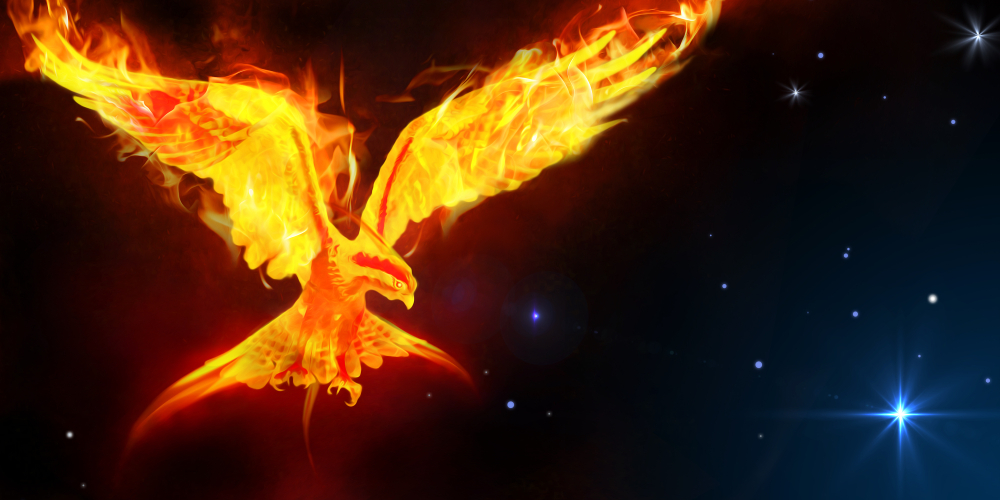The Legend Lives On: Exploring 10 interesting Facts About the Phoenix Bird

The Phoenix, a magnificent and mystical bird, captures the imagination like no other mythical creature. Born from the ashes, this symbol of death and rebirth weaves through the tapestry of various cultures, embodying the endless cycle of life’s demise and renewal.
The Phoenix mythology, rich and complex, spans across ancient civilizations, from the sun-worshipping Egyptians to the philosophical Greeks, each adding their unique hue to its legend. This mythical bird’s ability to rise from its ashes has rendered it a powerful symbol of immortality, renewal, and resilience, making it an enduring metaphor for overcoming adversity.
Throughout history, the Phoenix has not only been a figure of myth and legend but has also held a significant place in the cultural consciousness of societies around the world. Its image has been adopted by cities as a symbol of hope and rebirth, prominently featured in literature and art, and even used to represent spiritual rebirth in religious texts.
The importance of the Phoenix in various cultures underscores not just the human fascination with eternal life but also our innate resilience and our constant quest for regeneration amidst despair.
Join us as we explore the enigmatic allure of the Phoenix bird, unraveling 10 fascinating facts that shed light on its legendary existence and its lasting legacy across different civilizations and through the ages.
1. Origin of the Phoenix Legend
The enigmatic origins of the Phoenix legend trace back to ancient mythologies, where it first emerged as a symbol of rebirth and immortality. This mythical bird is most prominently featured in Ancient Egyptian mythology, known as ‘Bennu’, believed to be a self-created being that played a significant role in the creation myth.
It was associated with the sun, creation, and rebirth, embodying the cycle of life, death, and rebirth. Similarly, in Greek mythology, the Phoenix was a symbol of renewal, famously reborn from its own ashes after a lifespan of hundreds or even thousands of years.
Ancient Greeks believed that the bird resided in Arabia, near a cool well, and every morning would bathe in the water and sing a beautiful song.
The astonishing tales of the Phoenix, spanning from the Sun Temple of Heliopolis in Egypt to the literature of the Greeks, portray a creature of unmatched beauty, epitomizing the eternal cycle of regeneration and the transcendent nature of life itself.
These myriad tales laid the foundational stones for the Phoenix’s symbolic presence across various cultures throughout history, each culture adapting the legend to its own set of beliefs and values.
2. The Lifespan of a Phoenix
The mythical Phoenix, known for its incredible lifespan and cycle of rebirth, is a fascinating subject for many folklore enthusiasts and scholars alike. According to legend, this awe-inspiring bird lives for several hundred years, or even up to a millennium, before it meets its fiery demise.
However, its death is not the end but rather the beginning of a new cycle. From the blazing pyre of its predecessor, a new Phoenix arises, reborn from the ashes, thus continuing the endless cycle of life, death, and rebirth.
This unique aspect of the Phoenix’s life cycle symbolizes the concepts of eternal life, resurrection, and the enduring nature of the soul. The image of the Phoenix bursting into flames at the end of its life, only to emerge renewed, is a powerful allegory for renewal, transformation, and the indomitable spirit of life itself.
This extraordinary lifecycle has cemented the Phoenix’s place not just in mythology, but also as a symbol of hope, illustrating that from endings can come new beginnings.
3. The Phoenix’s Rebirth Process
The rebirth process of the Phoenix is a mesmerizing cycle that captures the essence of renewal and eternal continuity. At the end of its long life, the Phoenix is consumed by flames, only to emerge anew from the ashes of its predecessor, symbolizing the cycle of life, death, and rebirth.
This process is not merely about physical rebirth but also carries profound symbolic meanings. It signifies transformation, the idea that end is just the beginning of something new, and the infinite cycle of the cosmos.
The Phoenix’s ability to rise from its ashes represents the resilience and perseverance of life itself, echoing the human spirit’s ability to recover and regenerate against all odds.
This powerful symbolism resonates across cultures, making the Phoenix not just a mythological creature but also a timeless emblem of hope, rebirth, and the invincible nature of life.
Through the Phoenix, we are reminded that even in the face of complete destruction, there is the potential for incredible rebirth and renewal, a message that holds as much significance today as it did in ancient times.
4. Physical Description of the Phoenix
The physical description of the Phoenix varies across the myriad myths and cultures that celebrate its existence, yet there are common threads that paint a picture of its splendid and fiery beauty.
Typically, the Phoenix is depicted as a large bird, dazzling in its form, with feathers that glimmer with the vibrant hues of red, orange, and gold, mirroring the fiery blaze into which it is reborn.
Ancient texts and folklore often describe its eyes as bright as stars, a beak as sharp as the strongest blade, and a majestic aura that radiates the warmth of the sun.
In some tales, the Phoenix is adorned with a nimble crest atop its head and a tail of splendid colors, casting a resplendent silhouette that captures the essence of fire and sun combined.
This awe-inspiring appearance not only underscores the Phoenix’s association with the fire and the sun but also its lofty status among mythical creatures.
Whether rising from the ashes in ancient Egyptian lore or singing its melodious tune in Greek mythology, the Phoenix’s descriptions convey a creature of unmatched beauty and strength, embodying the majesty of its symbolic rebirth and renewal.
5. The Phoenix Across Cultures
The Phoenix, a symbol of eternal rebirth and boundless regeneration, permeates diverse cultural landscapes, each offering a unique lens through which to view this immortal bird. In the tapestry of world mythologies, the Phoenix’s essence is consistently woven with threads of renewal and cyclicality, yet the fabric of each narrative varies significantly across cultures.
Ancient Egyptian texts herald the Phoenix, or ‘Bennu’, as a harbinger of creation and rejuvenation, a creature deeply entrenched in the cosmology of life, death, and rebirth, embodying the sun’s life-giving power.
In contrast, Greek mythology presents the Phoenix as a lone marvel, a beacon of resilience that undergoes self-renewal, emphasizing the personal journey of rebirth over cosmic cycles.
Farther East, in Chinese mythology, the Fenghuang reigns not as a symbol of fiery rebirth but as a harmonious union of male and female, capturing the essence of yin and yang, and portraying a gentler aspect of renewal through balance and duality.
This juxtaposition of the Phoenix narrative across Egyptian, Greek, and Chinese traditions showcases not only the universality of the theme of regeneration but also the rich variance in its depiction, reflecting each culture’s unique spiritual beliefs and values.
Through this comparative lens, the Phoenix emerges not merely as a mythological creature but as a global symbol of continuous transformation and enduring life, woven intricately into the human desire for renewal and transcendence.
6. The Phoenix in Literature and Popular Media
In literature and popular media, the Phoenix’s symbolic resonance of rebirth and resilience has been a captivating theme, manifesting in various forms that span genres and audiences. J.K. Rowling’s Harry Potter series presents one of the most beloved literary examples, featuring Fawkes, a Phoenix whose tears have healing powers and who plays a pivotal role in the protagonist’s journey, epitomizing loyalty, rebirth, and the cyclical nature of life.
In the realm of cinema, the X-Men franchise explores the Phoenix Saga, where Jean Grey embodies the Phoenix Force, depicting the theme of immense power, destruction, and rebirth, underscoring the duality of creation and annihilation.
Additionally, Ray Bradbury’s Fahrenheit 451 utilizes the Phoenix as a symbol for rebirth and renewal, highlighting the narrative’s critique of censorship and society’s opportunity for regeneration through the ashes of its downfalls.
Across these varied depictions, the Phoenix transcends its mythological origins, serving as a versatile symbol in narratives that explore the depths of human experience, the inevitability of endings, and the hopeful promise of new beginnings, reflecting the eternal human fascination with the cycle of life, death, and renewal.
7. Symbolic Meanings of the Phoenix
The Phoenix, with its fiery plumage and cycle of rebirth, stands as a beacon of immortality, renewal, and resilience in the vast ocean of symbolism that spans different cultures and epochs.
Its very essence encapsulates the inevitability of change and the endless possibilities that arise from it. To contemplate the Phoenix is to reflect upon the quintessential nature of existence itself—where every end begets a beginning, and destruction paves the way for creation.
This mythical creature symbolizes not just the immortality of the soul and its continual renewal but also the resilience required to rise from the ashes of adversity.
In this capacity, the Phoenix transcends mere folklore; it becomes a universal emblem of human perseverance and the indomitable spirit to overcome, to begin anew in the face of obliteration.
Through the ages, this symbol has not merely lingered but flourished in the human psyche, resonating as deeply today as it did in ancient civilizations, reminding us of the power within to renew, regenerate, and rebirth our lives, societies, and spirits.
8. The Phoenix and Astrology
In the realm of astrology and spiritual practices, the Phoenix serves as a profound symbol of transformation and regeneration. This mythical creature’s cycle of death and rebirth resonates deeply with individuals seeking personal growth and renewal.
Astrologically, the Phoenix is often associated with the sign of Scorpio, symbolizing the process of profound change, spiritual rebirth, and the transcendence over personal and collective shadows.
It teaches that, just as it rises from its own ashes, one can emerge stronger and more enlightened from life’s challenges and adversities. The Phoenix’s imagery is also prevalent in alchemical traditions, where it represents the purifying process of turning base substance into spiritual gold.
In this context, the Phoenix is not just an emblem of cyclical renewal but also a guide for inner transformation, encouraging individuals to shed their old selves for profound spiritual awakening.
Its dynamic process of rebirth becomes an allegorical narrative for those on a path to self-discovery and reinvention, symbolizing the eternal nature of the soul and the endless opportunities for rebirth and transformation in one’s life.
9. Historical Sightings of the Phoenix
While no definitive historical records capture the physical manifestation of the Phoenix, the allure of this mythical creature’s sightings has captivated human imagination for centuries. Scholars and historians have examined various accounts and claims that hint at the Phoenix’s presence throughout different epochs and civilizations.
These accounts often intersect with significant historical or supernatural events, suggesting the Phoenix’s appearance as an omen or a marker of impending renewal or destruction.
In ancient texts, historians like Herodotus and Pliny the Elder debated the existence and nature of the Phoenix, pondering its cyclical rebirth and its purported longevity. Their descriptions, though speculative, are among the earliest attempts to ground the Phoenix in a semi-realistic context, blending the lines between myth and potential reality.
These discussions highlight not only the fascination with the Phoenix but also the human tendency to seek signs of hope and regeneration in the world around us.
The enigmatic nature of the Phoenix, coupled with its symbolic representation of life’s cyclical nature, has ensured its presence in oral traditions and ancient manuscripts, making it a recurring symbol of mystery and rebirth across cultures and centuries.
10. Modern Day Interpretations of the Phoenix
In contemporary society, the Phoenix continues to be a powerful emblem, embodying concepts of resilience, renewal, and hope amidst adversity. Its timeless narrative of rising from the ashes resonates profoundly with individuals facing personal or collective challenges, serving as a metaphor for overcoming obstacles and experiencing rebirth.
Modern interpretations of the Phoenix are plentiful and varied, spanning numerous cultural contexts and media forms. In motivational literature and self-help resources, the Phoenix symbolizes the ability to rebound from setbacks stronger and more determined.
In the environmental movement, it represents nature’s resilience against human-induced challenges, reminding us of the potential for ecological recovery and conservation.
The Phoenix also makes frequent appearances in logo designs, branding, and tattoos as a symbol of transformation and the start of a new chapter in life. Its representation in modern art, film, and literature continues to evolve, reflecting contemporary values and the enduring human spirit’s capacity to regenerate.
Through these myriad interpretations and applications, the Phoenix not only maintains its relevance but also enriches the cultural tapestry of our times, offering inspiration and solace in the face of ongoing change and uncertainty.
Conclusion
In contemporary society, the Phoenix continues to be a powerful emblem, embodying concepts of resilience, renewal, and hope amidst adversity. Its timeless narrative of rising from the ashes resonates profoundly with individuals facing personal or collective challenges, serving as a metaphor for overcoming obstacles and experiencing rebirth.
Modern interpretations of the Phoenix are plentiful and varied, spanning numerous cultural contexts and media forms. In motivational literature and self-help resources, the Phoenix symbolizes the ability to rebound from setbacks stronger and more determined.
In the environmental movement, it represents nature’s resilience against human-induced challenges, reminding us of the potential for ecological recovery and conservation.
The Phoenix also makes frequent appearances in logo designs, branding, and tattoos as a symbol of transformation and the start of a new chapter in life. Its representation in modern art, film, and literature continues to evolve, reflecting contemporary values and the enduring human spirit’s capacity to regenerate.
Through these myriad interpretations and applications, the Phoenix not only maintains its relevance but also enriches the cultural tapestry of our times, offering inspiration and solace in the face of ongoing change and uncertainty.
In conclusion, the legend of the Phoenix bird captivates with its rich tapestry of death and rebirth, embodying the timeless themes of immortality, renewal, and resilience. This mythical creature, with its fiery demise and rebirth from the ashes, serves as a powerful symbol of the cyclical nature of life and the enduring spirit of regeneration.
The Phoenix’s mystical allure, spanning across cultures and epochs, highlights humanity’s perpetual fascination with the concepts of eternal life and the ability to rise triumphantly from adversity.
The exploration of the Phoenix through its captivating lore, historical debates, and its symbolic significance in contemporary society underscores the enduring legacy of this mythical bird.
Despite being rooted in ancient mythology, the Phoenix’s narrative continues to resonate deeply with individuals today, inspiring art, literature, and personal symbolism.
Its legacy is a testament to the human capacity for renewal and the unwavering hope for a brighter, rejuvenated future. The fascination with the Phoenix endures, reminding us that within each end lies the potential for a new beginning.
The legend of the Phoenix not only lives on but continues to inspire, drawing new generations into its fiery embrace and encouraging all to contemplate the boundless possibilities of rebirth and transformation.




